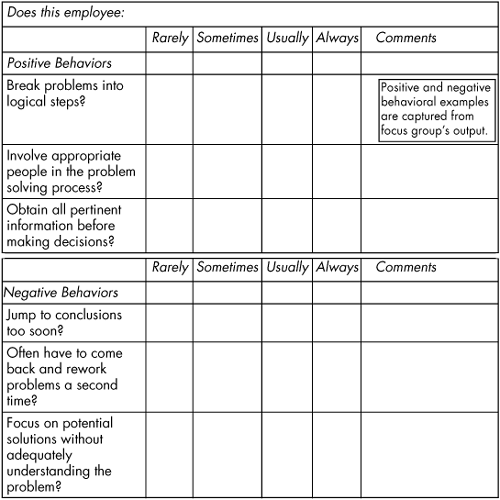The Matrix of Relationships
A matrix provides a strong visual display of variables and relationships. Figures 13.2 and 13.3 demonstrate a method for organizing and presenting variables to be considered for measurement in a staffing process. Figure 13.2 connects Attributes to Behaviors while Figure 13.3 connects Behaviors to Results. Once sound measures for each of the indicators are obtained, an analysis can be conducted to determine where the leading-lagging relationships exist and define the strength of the relationship. The Attribute to Behavior Matrix is shown in Table 13.1.
| Attributes | Licensing Exam | Reference Checks | Communications | Job Knowledge | Supervisor Ratings | Teamwork |
|---|---|---|---|---|---|---|
| Cognitive Ability | ||||||
| Problem Solving Test | ||||||
| Math Test | ||||||
| Grammar Test | ||||||
| Job Simulation | ||||||
| Simulated Customer Calls | ||||||
| Workstyle Scales | ||||||
| Tolerance for Ambiguity | ||||||
| Boredom Proneness | ||||||
| Coping with Pressure | ||||||
| Dynamic Work Environment | ||||||
| Empathy |
The Behavior to Results Matrix is shown in Table 13.2.
| New Sales | Renewal Sales | Attendance | Customer Complaints | |
|---|---|---|---|---|
| Licensing Exam | ||||
| Reference Checks | ||||
| Communications | ||||
| Job Knowledge | ||||
| Supervisor Ratings | ||||
| Teamwork |
In 2001, a study of a data entry position was conducted for a leading regional financial services firm. It was discovered that a test (leading indicator)—one that measured the ability to accurately match a string of characters to another string found in a group of four—had a strong relationship to the volume of data fields entered per hour (lagging indicator). More data fields per hour translate into fewer people for the same volume of work, or greater volume with the same head count. Either approach provides a competitive advantage on the cost/time of throughput for data entry (lagging indicator).
In another recent study (1998 to 2002) of call center staff for a national insurance company, it was discovered that a score on problem solving assessment had a strong relationship to passing a licensing test required to perform the job. By using this data, the company reduced the number of job offers to those less likely to pass the licensing test and thus reduced training investments and associated salary costs. Oddly enough, the range in scores of those achieving well on problem solving had little to no relationship to job performance. This is an example where the leading indicator predicts a critical threshold behavior, such as passing the test, but does not have a relationship with actual job performance. The candidates need to get the license to sell, but getting the license is not an indicator of ability to sell effectively.
This type of analysis requires accurately collected, well organized data on the relevant variables. The data needed to perform analysis of this nature requires a well designed measurement system. By examining the rigor of data capture used in accounts receivable or inventory control, one can see the database structure and the frequency and scope of data entry. Applying the same level of system design, detail definition, and data entry to staffing processes can produce metrics the organization can use to support business decisions from staffing strategies.


